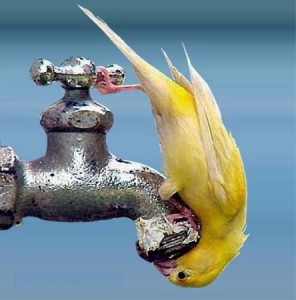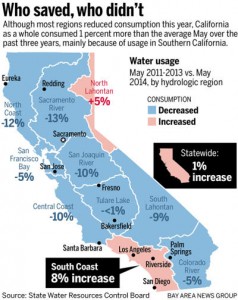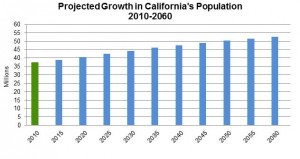California’s Drinking Problem: The Urgency to Use Less Water
Jul 16th, 2014 | By admin | Category: Water IssuesBy Suzanne York, www.howmany.org
It’s certainly not unusual for temperatures to be hot this time of year, as summer is in full swing in the Northern Hemisphere. But things are getting really, really hot across the globe.
Last month the Japan Meteorological Agency (JMA) reported that the period March-May was the hottest in more than 120 years of record-keeping. This week, the JMA added this past June to the list.Joe Romm of Climate Progress writes that “It seems all but certain more records will be broken in the coming months, as global warming combines with an emerging El Niño.”
This is bad news for California. Despite being in the grasp of a 3 year long drought, despite Governor Jerry Brown’s plea in January to voluntarily reduce water usage, Californians actually increased their water use amid the worst drought in decades. Now mandatory restrictions and fines are being put in place.
Perhaps unsurprisingly, it’s coastal southern California – home of massive freeways and suburbs, and love of cars and pools and endless sun – where water consumption has risen this year.
A survey by the state water board found that water consumption in the San Francisco Bay Area dropped 5 percent. But in coastal California, south of Santa Barbara, consumption rose 8 percent.
How bad is the drought, and how bad is it that some Californians are not reducing water consumption? As of July 8th, 36% of the state was facing exceptional drought conditions; every part of California is experiencing what is considered severe drought.
Felicia Marcus, the water board’s chairwoman, stressed that “California is in the worst drought we’ve seen in our grandparents’ generation or beyond.” She said “Fields are going fallow. Thousands of people are going to be out of work. There are communities that are out of water — they’re bathing out of buckets and water trucks are coming in to help them.
“But many parts of California don’t seem to realize how bad it is,” she said, “because they are so far away from their source of water. We are all in this together, and this is not a time to waste water.”
That is the crux of the problem, and extends to many resource issues in our modern society (such as food). California just seems to keep on growing, with little thought to what that means. Yes, some people and some communities understand the impacts, but overall it’s the “growth is good” mentality and maybe not exactly damn the consequences, but at least push it off to future generations.
California is the most populous state in the union, with 38 million people. The population is projected to increase to nearly 50 million by 2050. This will lead to increased demand for both drinking water for cities and irrigation water for farms, and will continue to strain the drought-prone state’s freshwater resources.
The latest figures from the California Department of Finance projects that Southern California will lead the state’s growth over the next 50 years, growing by 8.3 million to 31 million in population.
By 2060, California will have 13 counties of one million or more, with eight of those with two million or more residents. Six of the counties with at least one million will be inland counties (read: hot and dry areas).
The reality is that 38 million people live in a mostly dry state. This number is increasing, for the time being, which means unless we reduce our consumption of precious resources like water, we will experience more strain on our communities and environment.
We can’t live in arid conditions and expect green lawns without paying a price. But there is much we can do to sustainably adapt to a drought that might be with us for some time, and it starts with using less water.
So far, not everyone is pulling his/her fair weight. All citizens, municipalities and businesses need to step up and figure out how to live with less water. California has been a leader on many environmental issues in the past; now the state needs to show the way to a smaller water footprint.
Suzanne York is a senior writer with the Institute for Population Studies.



